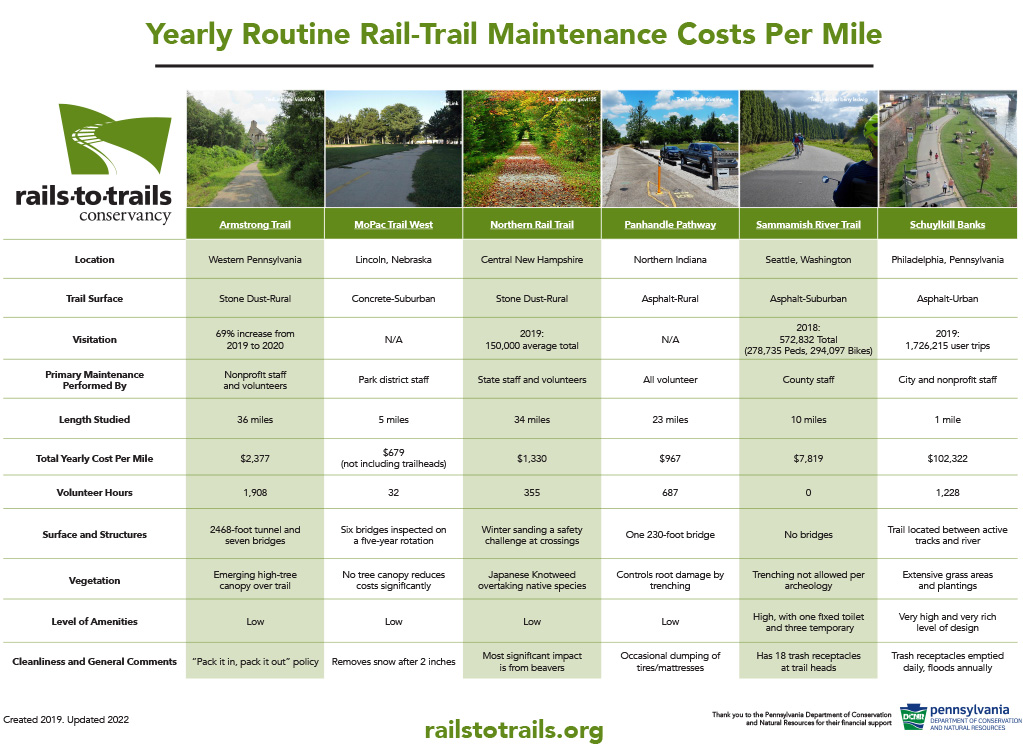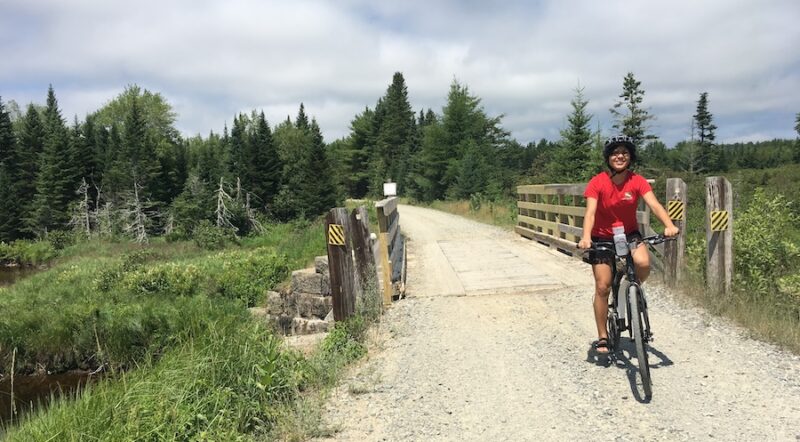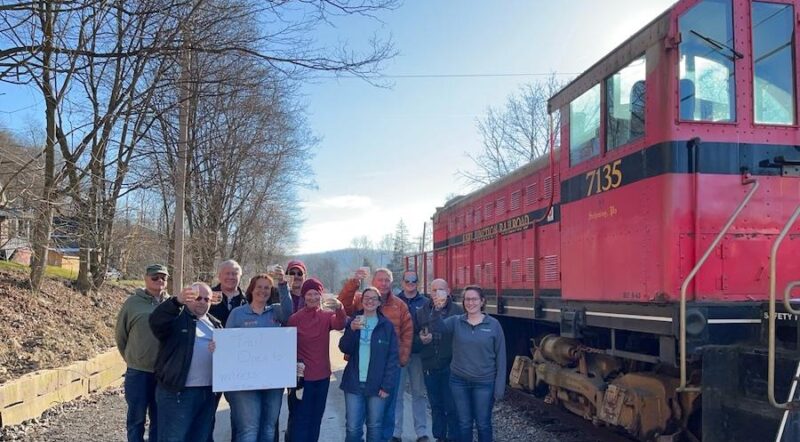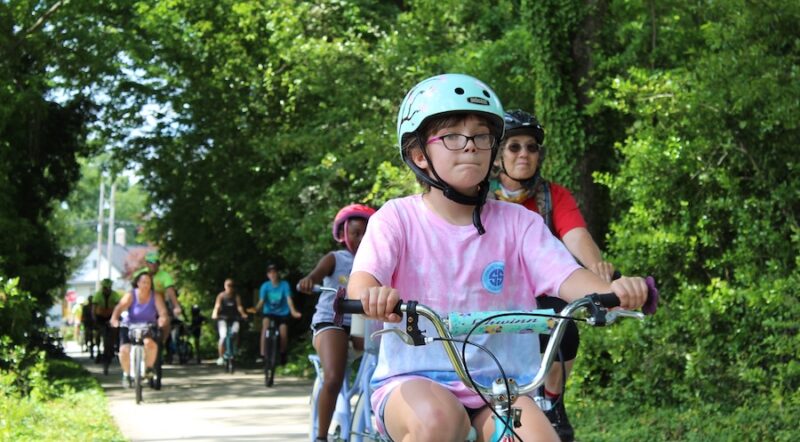Maintenance Basics
W&OD Trail Clean Up | Photo by Anthony Le
Page Navigation
- Maintenance Costs →
- Elements of a Trail Maintenance Program →
- Responsibilities for Trail Maintenance →
- Maintaining Rail-with-Trail →
Proper maintenance is essential to the long-term success of your trail. Maintenance refers to the physical tasks done to keep the trail safe and serviceable. A trail facility that is consistently maintained has a lower cost over time than one that needs major rehabilitation work from a lack of consistent maintenance. Without consistent maintenance, trails can quickly fall into disrepair, making the trail unpleasant and even dangerous for users. In contrast, a well-maintained trail provides users with a positive experience, encouraging them to keep returning to it. Potential users are attracted, and negative behaviors such as vandalism and dumping can be deterred, when it is apparent that the trail is cared for.
The topmost reason to maintain a trail is to ensure the safety of trail users. Good maintenance practices also:
- Prolong the useful life of the trail
- Promote positive relationships with adjacent landowners
- Reduce potential legal liability when an accident occurs on the trail
- Help avoid costly repairs
- Create a sense of stewardship and pride in the community
Planning for maintenance should begin as early as possible in the trail development process. Determine who will be responsible for maintenance, how maintenance will be performed, anticipated maintenance costs and possible funding sources of maintenance before the trail is built as these will be crucial to the long-term sustainability of the trail.
Keep maintenance in mind when coming up with the design of the trail. This will affect the decisions made about the trail itself – trail surface, route alignment, trailside amenities like seating, signage, restrooms, trailheads and so on. It takes personnel, equipment and money to maintain these elements at or near the design level.
Good workmanship and quality materials can help lower costs of maintenance in the long-run. The design, construction and maintenance of trails should adhere to the relevant national standards including the AASHTO Guide for the Development of Bicycle Facilities; National Association of City Transportation Officials (NACTO) Urban Bikeway Design Guide; and ADA’s Public Rights-of-Way Accessibility Guidelines (PROWAG). States and local agencies often have their own standards for design of pedestrian and bike facilities.
It is easier to mobilize funding to construct a trail than it is to find money for maintenance. All too often, this leads to deferred maintenance, where maintenance activities are postponed due to a lack of funds, labor or equipment. This can cause something that started as a minor problem to evolve into a bigger, costlier problem. In certain cases, it may make more sense to invest more in the front end, during design and construction, in order to avoid long-term maintenance headaches.
For the purposes of this page, maintenance generally refers to routine activities that happen at least once a year and are necessary to keep the trail safe and usable. These include tasks like sweeping/blowing debris from the trail, mowing of shoulders, vegetation management, trash pickup, cleaning graffiti and drainage maintenance.
Maintenance Costs
Whether you are building a new trail or already maintaining one, it is critical to determine your maintenance costs. Once you determine baseline costs you can more accurately determine if your practices and methods are cost-effective. Rails-to-Trails Conservancy, together with several local trail managers, has created a worksheet to enable you to capture your maintenance costs and compare them to other trails. Some examples are given in the table below.

Click here for a link to the full table and explanation of table components
Using essential maintenance task-costs submitted by trail managers via the worksheet, RTC has been able to create the table above to quickly give a general sense of the routine maintenance cost per mile of various types of multiuse trails in different regions of the United States. This information helps trail managers gain an understanding of the wide range of costs, help determine what a new project’s costs will be, or make some general comparisons to their existing trail. However, solely relying on other examples is not accurate enough. You need to prepare your own budget.
The survey worksheet and the routine maintenance costs table are continuation of the work done on Rails-to-Trails Conservancy’s (RTC’s) 2015 study, Maintenance Practices and Costs of Rail-Trails which details the results of a comprehensive survey of 200 trail managers on the type, scheduling and costs of major maintenance tasks. They represent the distilling of the study’s 117 questions into four broad, general categories: surface, vegetation, amenities and cleanliness.
This is just the start of a more robust list of data points that can help inform maintenance costs and best practices for many types of trails, locations and other variables. If you would like to share your data with RTC, please contact Northeast Regional Director, Tom Sexton at tom@railstotrails.org.
Elements of a Trail Maintenance Program
The following tools can help ensure that maintenance is done in an organized and efficient way.
Trail Inventory
To help manage maintenance, start by creating an inventory of the physical assets of the trail, including the features along the trail including signage, seating, trash cans, fitness stations, restrooms and trailhead features. This can be done by walking the trail and recording these on a list, together with photos. Some trails have the assets listed on a simple spreadsheet, others make use of software tools like Geographical Information System (GIS) to create a map of the trail’s right-of-way and visualize the waypoints along it. This database or list should be kept updated.
Inspections checklist
Once you have a list of all the trail elements, the next step is to list all possible maintenance actions needed to keep those facilities safe and functional. Assign actions to each piece of the trail.
With this information you can begin to create a standard checklist to use for inspections on the trail. Work orders will be as a result of any defects or needs observed during inspections.
Maintenance Priorities
Define your maintenance priorities i.e. high, medium and low priority tasks. Any activities necessary to keep trail users safe on the trail should be prioritized. On the other hand, purely cosmetic enhancements might be lower on the priority scale. In the Santa Clara County’s Trails Maintenance Guidelines, the top priority went to those maintenance actions which, if not done, would cause the most severe damage. Emergency drainage was top on their list (an urgent, non-recurring task), while other preventive maintenance tasks like minor structure repair, drainage repair and clearing vegetation followed. Priorities don’t need to be fixed and can be reviewed over time.
Maintenance Schedule
A trail maintenance schedule should include the following:
- List of tasks
- Frequency of tasks
- Cost per application
- Annual costs
- Responsible party
An instruction sheet or manual detailing just how to carry out these tasks might be helpful to have.
User Reporting
Figure out a mechanism that allows for trail users to report any observed defects or hazards on the trail. This can range from having contacts for the trail manager at trailheads, to a mobile app which allows them to submit requests directly to the party responsible. For some municipally-owned trails, residents can use the city’s existing 311 (non-emergency) service to request trail maintenance. Mile markers are useful as they can help users pinpoint where the hazards are along the trail. Keep track of these requests and follow up with the user to maintain goodwill with the community. Columbus and Franklin County Metro Parks (OH) has a voluntary text alert system that users can opt into to be notified about trail closures, hazards and construction activities.
Tracking
When requests are made either as a result of a routine inspection or a tip from a trail user, they should be logged and a work order created. Have a maintenance management system which includes a database of maintenance records and work hours. This will allow staff to better prioritize, schedule and track the status of work orders. Also make sure to track volunteer hours along your trail. Do a compilation annually to show the monetary amount of labor spent by the community supporting the trail and, when possible, use that amount as part of a local “match” for grant applications.
Budgeting
As stated earlier, the costs of maintaining the trail should be factored into the long-term costs of trail management before the trail is built. Once you have decided on the maintenance tasks, attach an estimated cost to each. The costs of maintenance vary from trail to trail and depend on a variety of factors including the trail’s geographical location, trail conditions, labor availability and so on.
Remember that your budget will be a living document. Once the work of maintaining the finished trail begins, keep a good record of actual costs. Review actual versus budgeted costs to help make your future budgets more accurate.
The main state source of funds for maintenance is the Recreational Trails Program (RTP) set-aside of Transportation Alternatives. The Recreational Trails Program provides funds to the States to develop and maintain recreational trails and trail-related facilities for both nonmotorized and motorized recreational trail uses. Read more about RTP and how trails have approached raising money for maintenance in the Maintenance Funding page in this toolbox.
Maintenance Plan
All of the above elements should be written down in a maintenance plan. Not only does the plan act as a reference – detailing maintenance tasks, activities, priorities, costs, funding sources, roles and responsibilities – it can also help protect against liability by showing that the trail management is not negligent about maintenance. A maintenance plan should be created for project trails (as part of a feasibility study, for example) as well as for existing trails.
Examples of trail maintenance plans can be found in the related links on the top right of this page, as well as in the Resource Library.
Responsibilities for Maintenance
The work of maintaining trails often falls to the entity that owns and manages the trail. In many cases, that is municipal, county or state agencies, while in others, it is the private organization that owns and manages the trail. Trail maintenance can be performed by staff associated with the trail, volunteers, or a contractor; often a mix of all three. Even if primary maintenance on the trail is being done by volunteers, trail managers will often be responsible for at least part of the maintenance work such as mowing and maintaining trailheads. The most crucial thing to remember about this is to decide who is responsible for what before the trail is built, during the planning process.
Public Agency Staff
Public agency management can happen in different ways, from parks departments and public works departments of municipalities and counties to other entities like regional park districts or state agencies, depending on the scale of the trail.
Local governments are more likely to employ staff with technical knowledge and access to the necessary equipment to perform maintenance. These agencies are also better equipped to negotiate with other public agencies such as utilities and water resources management agencies to share responsibilities for maintenance.
It’s important, if a local government is expected to take on maintenance, to have their maintenance staff weigh in on the trail’s design. These staff may have preferences, such as removable bollards to allow maintenance vehicles onto the trail. With their suggestions addressed, the agency can more seamlessly integrate the maintenance of the trail with its other maintenance works.
Have maintenance agreements with the relevant public partners ready to go before construction. Be sure to also start the funding conversation early enough to get money set aside. When a local parks department or public works department oversees maintenance, they can include trail maintenance in their own operations and maintenance budget. In this sense, funding for maintenance can be more stable when compared to a non-profit trail group that may have to constantly seek money for maintenance. However, because government priorities tend to change, funding for maintenance might be cut or reallocated to a different priority from one budget cycle to the next.
Volunteers
Volunteers often provide much needed labor for maintenance, performing tasks such as removing fallen branches and trees from the trail, clearing brush, mowing, trash pick-up, cleaning and painting benches and plowing the snow on winter trails. Community members and businesses can also donate equipment for trail maintenance. On the North Coast Inland Trail in Ohio, volunteers used their own rollers, graders and excavators to construct and maintain the trail, while being compensated for gas and supplies by the trail’s managers.
Maintenance activities provide opportunities for folks with varied interests, skill levels and time commitments to contribute to the trail. Work days and clean-up events are good for engaging one-time volunteers. Some trails have programs for more committed volunteers, who are assigned a section of trail and then trained to do regular inspections, perform light maintenance and report any issues to the trail staff. Common titles for these types of programs include Trail Rangers, Trail Stewards and Trail Ambassadors.
Enlisting volunteers not only saves on maintenance costs but also creates a sense of pride and stewardship of the trail. However, it can be difficult to keep momentum going with volunteers as enthusiasm wanes or personal circumstances change, and volunteers may also lack the technical expertise to do more complex repairs. There are also insurance implications of working with volunteers for instance, if a volunteer is injured, or damages property, or a third person is injured as a result of work performed by volunteers
The RTC report Community Built: Stories of Volunteers Building and Maintaining their Trails provides case studies of volunteer involvement in trails work.
Contracted Services
Private contractors can be brought in where:
- Major/emergency repairs are needed
- Specialized skills or equipment are necessary to complete a maintenance activity
- Volunteer or staff capacity is too limited to perform maintenance tasks in-house
Contracting can reduce costs of owning equipment and hiring labor, but trail managers should shop around to ensure they get the best value for money. Non-profit trail groups should check with local governments whether there are existing maintenance agreements to get the services at a lower cost.
In the 2015 RTC Northeast Regional Office maintenance report, trail managers reported that the most commonly contracted maintenance tasks were “tree removal, restroom maintenance, herbicide application, bridge inspections and clearing of drainage culverts and mowing.”
Maintaining Rail-with-Trail
Rails-with-trails have all the same maintenance needs as any other shared use paths, but there are additional considerations that come with being located adjacent to an active railroad’s right-of way. Railroads usually have to approve the design of the trail. In addition, some railroads have additional requirements for maintenance of the trail, such as notifying the railroad when they need access to the right-of-way in order to complete any emergency or routine works. Trail managers will often be solely responsible for any maintenance within the trail’s easement, including the trail itself, fencing, signage, vegetation and any structures such as culverts, retaining walls and bridges. In general, railroads will stress that the operation and maintenance of the trail should not affect the railroad’s own operations.
Trail managers of RWT must also consider the maintenance needs of the railroad on the adjacent track. Often maintenance of tracks, drainage facilities or other railroad structures is done from the track itself, or using trucks driven on adjacent maintenance road. This work may end up interfering with the use of the trail, requiring it to be closed until the work is complete.
RWT that are in close proximity to the tracks may end up acting as the maintenance roads for the railroad. The design of the trail should be adjusted to accommodate this e.g. a trail that can handle load of heavy trucks and equipment; easily removable fences or fences with gates; gates for closing the trail and signs about possible trail closures.
An operations and management plan for a RWT should detail the procedures and responsibilities of each party when the railroad needs access to the trail, or when the trail manager requires access to the railroad’s right-of-way. It should also outline trail closure procedures.
Even work not done directly on the trail can end up impacting it, for example, snow removed from the tracks might end up obstructing the trail; or debris might be left over from maintenance work. It is usually the responsibility of the trail manager to close the trail when public safety is at stake. The responsibility and recourse for damage to the trail due to activities on the track should be discussed and spelled out in the operations and maintenance plan or the lease agreement/ with the railroad. The FHWA report, Rails-with-Trails: Best Practices and Lessons Learned (2020) provides additional background on how trail groups have approached maintenance of rails-with-trails.
Resources
‣ Report- Yearly Routine Rail-Trail Maintenance Costs Per Mile
‣ Report- Maintenance Practices and Costs of Rail-Trails (2015)
‣ Webinar – Routine Maintenance Costs for Four Season Trails
‣ Fact Sheet – Trail Maintenance Budget Worksheet
‣ Fact Sheet- Sample Paved Trail Maintenance Schedule
‣ Fact Sheet- Sample Paved Trail Inspections Checklist
‣ Report – Albany-Hudson Electric Trail: Trail Maintenance Plan
‣ Report- Two Rivers Greenway Maintenance Plan
‣ Report- Best Practices in Trail Maintenance: A Manual by the Ohio River Greenway
‣ Report- Santa Clara County Trail Maintenance Manual
‣ Report- Best Practices for Bicycle Trail Pavement Construction and Maintenance in Illinois
‣ Report- Rails-with-Trails: Best Practices and Lessons Learned (2021)
Maintenance Stories
View More Blogs
Bridging the Gaps: Maine’s Vision for a Statewide Interconnected Trail Network

Pennsylvania’s Armstrong Trails

Georgia’s Cricket Frog Trail
TrailNation Collaborative
TrailNation™ Collaborative is a nationwide peer learning community from Rails to Trails Conservancy that brings together advocates, leaders and professionals from across disciplines to establish and accelerate trail networks across America. The collaborative provides proven tools, methods and resources, combined with RTC’s expertise and network of partners across the country, to accelerate the development of connected trail systems. When trails are connected across regions and states, trail networks have a proven transformative impact—they are essential infrastructure that creates thriving, healthier communities.